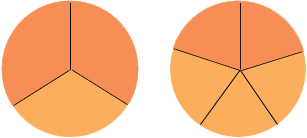 |
 |
| Name: J. Who is asking: Parent Level of the question: Elementary Question: how can you compare fractions with like numerators and UNlike denominators, like 2/3 and 2/5, without renaming or using fraction strips? |
| Hi J.
Think about it this way: the numerator is what you share, the denominator is how many ways it has to be shared. For example, 3/7 might represent 3 basketballs shared by 7 players practicing on a court. Or 2/3 might be 2 dollars split between 3 children. Improper fractions work too: 9 marshmallows roasting on 7 sticks would be 9/7. So if we have the same amount to share, but more people or things doing the sharing, then that means each sharer has a smaller portion. If 2 chocolate bars are shared between 3 children (2/3) and then you add two more children to the situation, you have the same 2 chocolate bars that 5 children now have to share (2/5). It should be clear that if you increase the denominator the children are less happy because they have less. Mathematically, that means 2/5 < 2/3. You can see it works the opposite way too: if the lottery jackpot is 1 000 000 Euros and five people share it (1 000 000/5) then that fraction is less than if fewer people share it. Stephen La Rocque> Hi J. I would think of cutting a pizza. For 2/3 I cut it into three equal size slices and then give you two of them. Thus you have two-thirds of a pizza. For 2/5 I cut it into five equal size slices and then give you two of them. Thus you have two-fifths of a pizza.
Which amount is larger? Penny |
 |
 |
 |
